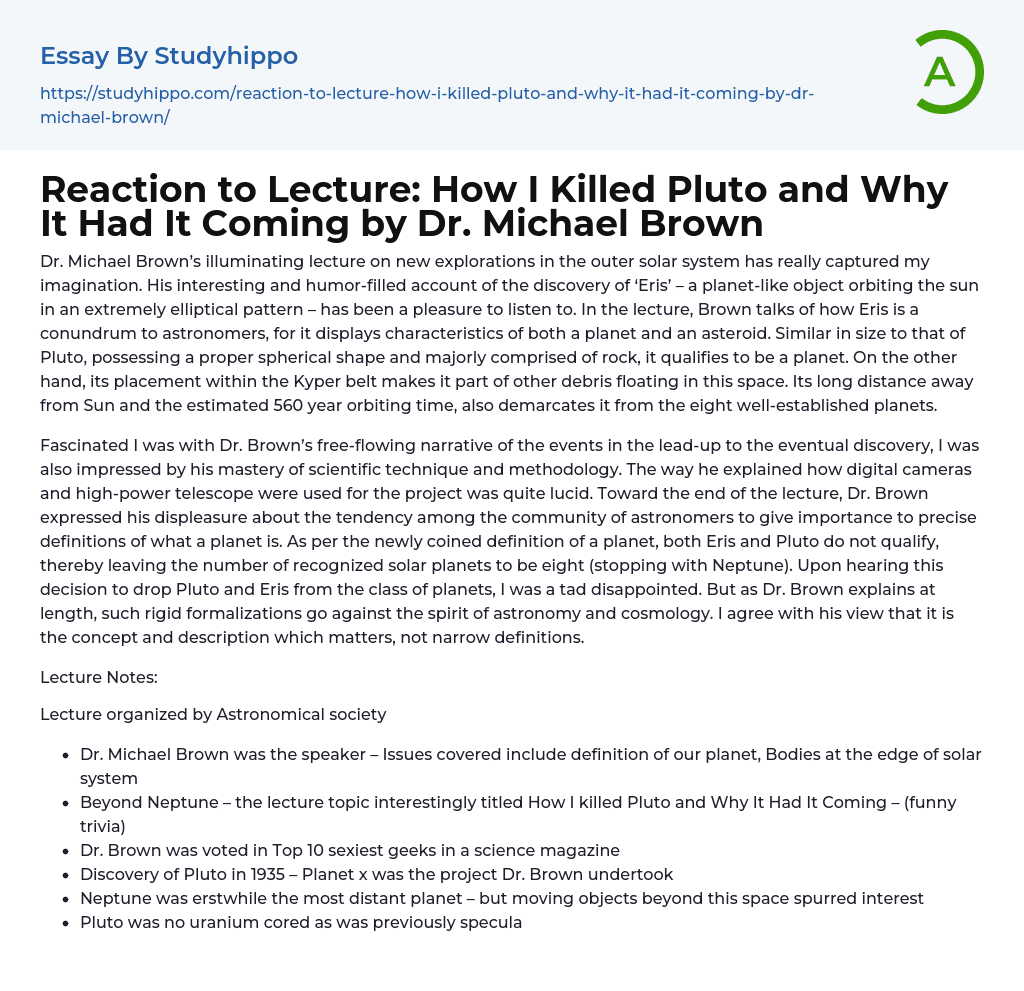

Reaction to Lecture: How I Killed Pluto and Why It Had It Coming by Dr. Michael Brown Essay Example
Dr. Michael Brown's captivating lecture on recent advancements in the outer solar system has truly engaged my curiosity. His entertaining and informative narrative about the finding of 'Eris' - an object resembling a planet that follows an exceptionally elliptical orbit around the sun - has been a delight to partake in. During his presentation, Brown discusses how Eris presents a perplexing situation for astronomers as it shares traits of both a planet and an asteroid. Being comparable in size to Pluto, having a spherical form, and primarily consisting of rock, it meets the criteria to be classified as a planet.
In contrast, being located in the Kyper belt associates it with other floating debris in this region. Furthermore, its significant distance from the Sun and estimated orbiting time of 560 years distinguish it from the established eight planets. Dr. Brown's captivating narrative
...of the events leading to the discovery fascinated me, as did his expertise in scientific techniques and methodology. His clear explanation of the utilization of digital cameras and high-power telescopes for the project was impressive.
Dr. Brown expressed his dissatisfaction with astronomers' focus on precise definitions of planets toward the end of his lecture. According to the new definition, both Eris and Pluto no longer meet the criteria, resulting in only eight recognized solar planets (ending with Neptune). While I was initially disappointed by this decision, Dr. Brown further explains that strict formalizations contradict the essence of astronomy and cosmology.
Michael Brown's lecture, titled "How I killed Pluto and Why It Had It Coming," organized by the Astronomical Society, discussed various topics including the definition of our planet and bodies at the edge of the sola
system. The lecture focused on what lies beyond Neptune and Dr.Brown's project, Planet X, which led to the discovery of Pluto in 1935. Before this discovery, Neptune was considered the most distant planet. However, moving objects beyond Neptune generated further interest.
In 1992, it was revealed that Pluto was actually part of the Kuiper Belt, a collection of hundreds of other orbiting objects. Despite this revelation, Pluto remained classified as a planet until 2002. Dr.Brown used automated computers with a telescope and digital camera to capture sequential photographs of space for comparison purposes. This method led to the discovery of moving objects like Eris.
Initially believed to be larger than Pluto, Eris is now estimated to be approximately the same size but much farther from the sun – almost three times as far as Pluto. The debate over whether Eris should be classified as a planet raises questions about how astronomers define planets. Both Pluto and Eris lost their status as planets; however, Dr.Brown played a significant role in redefining our understanding of these celestial bodies at the edge of our solar system through his research on Planet X and his discoveries regarding their true nature within the Kuiper Belt using advanced technology such as automated computers with telescopes and digital cameras for capturing sequential photographs.Space exploration has undoubtedly been revolutionized by such advancements in technology underpinning breakthroughs in understanding planetary dynamics beyond traditional boundaries established before these recent discoveries were made known to scientists worldwide.This transformative work continues shaping future scientific inquiry into similar cosmic phenomena awaiting further exploration awaiting us just beyond where once limited knowledge had confined human curiosity.Let us continue embracing new horizons
while acknowledging past achievements through commemorating those who spearheaded progress in this exciting field of study.During his lecture at the Astronomical Society event, Michael Brown highlighted that according to the information he provided, the classifications of celestial bodies should not be given much importance. Brown's lecture focused on the discovery of Eris and also delved into his book titled "How I Killed Pluto and Why It Had It Coming." He described Eris as a spherical celestial body primarily made up of rock, similar in size to Pluto. These characteristics make it eligible for classification as a planet.
On the other hand, being located within the Kyper belt places it among other debris in this region. Furthermore, its significant distance from the Sun and estimated orbiting time of 560 years distinguish it from the eight recognized planets.
- Animals essays
- Charles Darwin essays
- Agriculture essays
- Archaeology essays
- Moon essays
- Space Exploration essays
- Sun essays
- Universe essays
- Birds essays
- Horse essays
- Bear essays
- Butterfly essays
- Cat essays
- Dolphin essays
- Monkey essays
- Tiger essays
- Whale essays
- Lion essays
- Elephant essays
- Mythology essays
- Time Travel essays
- Discovery essays
- Thomas Edison essays
- Linguistics essays
- Journal essays
- Chemistry essays
- Biology essays
- Physics essays
- Seismology essays
- Reaction Rate essays
- Roman Numerals essays
- Scientific Method essays
- Mineralogy essays
- Plate Tectonics essays
- Logic essays
- Genetics essays
- Albert einstein essays
- Stars essays
- Venus essays
- Mars essays
- Evolution essays
- Human Evolution essays
- Noam Chomsky essays
- Methodology essays
- Eli Whitney essays
- Fish essays
- Dinosaur essays
- Isaac Newton essays
- Progress essays
- Scientist essays



